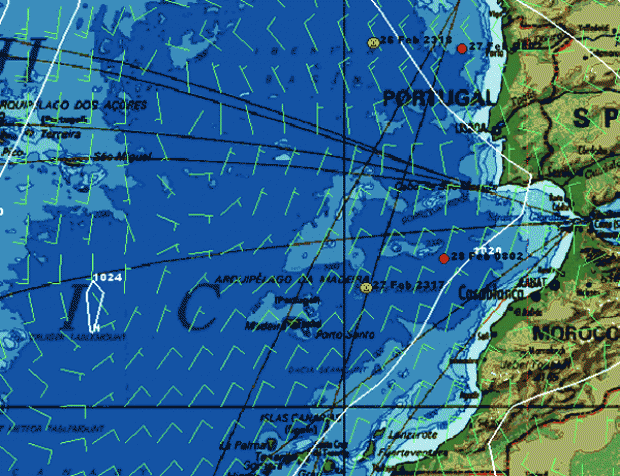Different strategies
Saturday February 28th 2004, Author: James Boyd, Location: Transoceanic
An interesting variation in strategy is taking place on the water between
Orange II and
Geronimo. De Kersauson on his maxi-tri has chosen the more direct offshore course while Bruno Peyron and the posse on
Orange II are choosing the more circuitous route - closer to the coast but longer. At present, if you take a position in the centre of the Cape Verde as a waypoint de Kersauson's tri is 126 miles ahead.
Despite the high pressure closing in the from the northwest de Kersauson managed the high mileage yesterday covering 472.5 in the 24 hours up until 2317 last night, while Orange II managed 464 until 0802 this morning. This is despite the forecast charts showing more pressure on Peyron's side of the race track.
At present a giant depression to the northeast of Newfoundland is pushing the Azores high southeast and while this morning it is centred to the south of the Azores over the course of today its centre will move east, closer to Madeira. Thus in theory Orange II out to the east should be sailing in 15-20 knot northeasterlies while Geronimo will be in 10-15 knots.
We shall see.
From on board Orange II navigator Roger Nilson wrote the following yesterday...
Did not dare to write this letter before we had passed the point of Portugal, where our crashbox fell off the morning of 19 Feb! Sailors are supersticious...
Our first attempt to beat the Jules Verne Trophy record, started on 18 February from Ushant and ended almost exactly 24 hours later about 160 nautical miles (nm) northwest of Lisbon. Our crashbox at the forward end of the starboard hull fell off without us hitting anything. At least we did not feel, hear or see any floating object which could have caused this 30cm shock absorber to be torn off.
We had gone downhill in a fresh northeasterly and made a pleasing 550nm in a day. It was less fun to beat back into big seas, 40 knots of icecold wind and our poor cat having to put it's blunt, hurt nose into it all.
After being shaken around for three days we tied up in Lorient on the morning of Sunday 22 February. In the most amazing speed the rig came off, boat was lifted on land and the boat's builders, Multiplast, put a team of their best people onto the job. Two days later, on the afternoon of Tuesday 24 February, the big cat had had her nosejob completed. Now her noses look a bit more classical and conservative. She was immediately put back into the water and her massive 48m wingmast restepped.
When we casted off late Wednesday evening, 25 February, we felt much more ready then we did before our first start. The first attempt on the JVT, served as our real test run for boat and crew - a test run we had never had time to do previously as our giant 38m catamaran only hit the water on 22 December.
Bruno and his crew & shore team have done an amazing job. From brand new boat to being ready to start a nonstop record attempt around the world in only 11 weeks.
In the process of writing this, a sail change took place from storm spinnaker to the larger medium gennaker and I had to rush up on deck. When the huge sail was rolling out, Jaco [Jacques Caraes] was at the bow and got hit by the roller furler just above his elbow. He staggered back to the cockpit, when I looked at him his eyes rolled back and he fainted.
After we'd put his feet up he is conscious again after just a few second. He was lucky we found no fractures, but certainly hematoma and pain.
Under 1000sqm of sail we are now pushing south and Jaco will lget the day off.
Back to the start.
At 0801GMT on Thursday 26 February we started again from Ushant. Claude Breton from the World Sailing Speed Record Council was there on the Island with his watch once again. Almost like a deja vu from our first attempt - same time of the day, same cold red morning light but northerly wind instead of northeasterly.
A speed record you can start whenever you like, as weather and wind are the only factors to deal with. We call that strategy. But we also have a tactical situation as Geronimo, skippered by 'The Admiral', Olivier de Kersauson, started just nine hours ahead of us.
One hour ago we found out that they are straight in front of us and have sailed almost exactly the same distance during the first 24 hours. They sailed 495 and while we had managed 494nm from point to point. 20.6 knots average does not impress a multihull sailor, but Bruno is a wise man and let the crew slowly come into the game. Not pushing too hard in the very beginning as we still are learning how to handle this massive, brand new, spectacular sailing machine.
Right now we are at the same latitude as Lisbon, 120nm to the West. The sun is starting to warm our bleak faces, pale from late hours work and lack of sun. But we are shining inside as we have just started two months of thrilling adventure.
Who is going to beat Bruno's record from 2002 nonstop around the planet, 64 days and 8 hours? The American 125ft catamaran Cheyenne, skippered by Steve Fossett started three weeks ago and is now 1.5 days ahead of Bruno's record. Are they going to beat the Jules Verne record first or is the 120ft trimaran, Geronimo or us on Orange II going to do it? Time will unfold the adventure of these three giant multihulls.









Latest Comments
Add a comment - Members log in